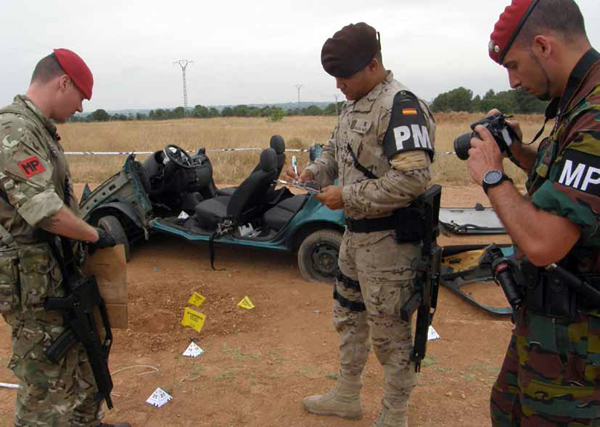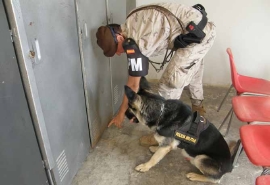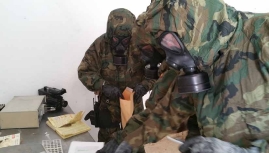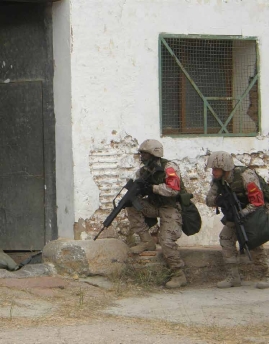- Home
- Feature Articles
- Full article
Protectors in Blue
Tuesday, July 21, 2015
Number: 017
The “Guardian Angel” exercise, led by the 1st Military Police Battalion, brought to Valencia military police personnel from Spain, Belgium and the UK

Multinational WIT investigates an attack against a vehicle
The “Guardian Angel” exercise, led by the 1st Military Police Battalion, brought to Valencia military police personnel from Spain, Belgium and the UK.

Searching lockers with the dog team

Collecting possible evidence at a clandestine lab

Clandestine lab
Military maps use normalised symbols to identify the different forces. In this system, blue includes own and friendly forces; red is used for hostile forces; green means neutral forces; and yellow indicates forces of unknown origin.
The expression “green on blue” started to be used in the context of the Iraq and Afghanistan missions to designate attacks against international troops by insurgents who have infiltrated the local security forces. The risk is especially high during training missions due to the close contact with the personnel being trained.
In those operations, the role of those who watch over the safety of trainers is therefore crucial. Which is why this year’s edition of 'Guardian Angel' – the most important exercise carried out by the Military Police in Spain – has included this scenario.
An attack of that nature is one of the most difficult situations to manage. In that context, MPs play the role of guardian angels for their colleagues – even more than is usually the case.
Participants in the training exercise included personnel from the Army (almost all the MP sections from the Land Force Brigade, the General Commands of Ceuta and Melilla and the Canary Islands Command), the Navy (a Naval Police company from the Protection Force), the Air Force (a squad), the Royal Guard (a section) and the Military Emergency Unit (a section), along with two squads from the British Royal Military Police, known as the Red Caps, and the Belgian Military Police Group.
But force protection is only one of the tasks undertaken by MPs in the theatre of operations, and the exercise allowed them to practise other skills. It included ten different scenarios spread around the Valencia province, in the training grounds of the bases in Bétera and Marines ('Jaime I' and 'General Almirante', respectively) and in the Cheste educational complex, on loan from the Valencian regional government. It was organised and led by the 1st MP Battalion, which belongs to the High Readiness Land Headquarters and serves as the model for all other MP units in the Army.
NBC risk
MPs can also be required to capture the leaders of a criminal gang which manufactures chemical weapons and to collect evidence of its activities. They have been trained to carry out that kind of policing task and had to apply that training in one of the scenarios. The operation was complicated by something going off in the laboratory, which meant that there was a risk of contamination. When someone shouted out 'gas, gas, gas', they knew it was time to put on their personal protective equipment (PPE) in order to complete their mission.
Captain David G. S., chief of the 1st Battalion Company and in charge of this simulation, noticed MO differences and similarities between the Naval Police and the Air Force Police and also between the different armies. One of the most important aspects of the exercise was that it made it possible to exchange techniques and learn from each other.
The 1st NBC Regiment “Valencia” collaborated in the exercise by setting up its Decontamination Station. Personnel who might have been in contact with contaminated material during the exercise would go through it once their participation was over.
Part of the team
MPs also work as members of WITs (Weapons Intelligence Teams) which, as their name indicates, are investigative teams specialised in weapons. They are made up of three specialists in intelligence, operations and explosives as well as an MP. The contribution of the latter is essential to collect evidence after an attack.
The team is put together ad hoc when an investigation needs to be carried out. It verifies that established procedures have worked and may suggest their revision. It checks whether there has been any change in the enemy’s MO. Furthermore, it keeps the chain of custody of the evidence to be forwarded to the judge.
WITs determine what constitutes evidence 'therefore its members have to be highly specialised', explains Staff Sergeant José Mª G. H., who has done the NATO WIT course. He was responsible for running the WITs station, which presented three scenarios: an IED attack on a vehicle; an insurgent taking advantage of the confusion caused by a bus accident in a village to place an explosive device; and a controlled explosion.
Multinational Section
This year saw the setting up of a Multinational Section made up of squads from the British Royal Military Police, the Belgian Military Police Group and the Spanish Battalion.
The British Army has an MP Brigade which includes the Royal Military Police, the Military Provost (charged with arrests and military prisons) and personnel to maintain base security. British Captain Dan Oakland stressed that the exercise had been useful to prepare for future operations and to focus on tasks specific to MPs, in addition to providing an opportunity to work with Spanish and Belgian colleagues. “We started off as three separate units, now we are only one,” he remarked.
Chief Petty Officer Walter Verbeke, chief of the Belgian squad, agreed. He highlighted that the activities had been useful to “smooth off the rough edges” between the different groups. In the case of Belgium, there are less than 200 MPs for 38,000 soldiers.
ARMY UNITS
- Araba Álava |
- Albacete |
- Alicante |
- Almería |
- Asturias |
- Ávila |
- Badajoz |
- Barcelona |
- Burgos |
- Cáceres |
- Cádiz |
- Cantabria |
- Castellón |
- Ceuta |
- Ciudad Real |
- Córdoba |
- A Coruña |
- Cuenca |
- Girona |
- Granada |
- Guadalajara |
- Gipuzkoa |
- Huelva |
- Huesca |
- Islas Baleares |
- Jaén |
- León |
- Lleida |
- Lugo |
- Madrid |
- Málaga |
- Melilla |
- Murcia |
- Navarra |
- Ourense |
- Palencia |
- Las Palmas |
- Pontevedra |
- La Rioja |
- Salamanca |
- Segovia |
- Sevilla |
- Soria |
- Tarragona |
- Santa Cruz de Tenerife |
- Teruel |
- Toledo |
- Valencia |
- Valladolid |
- Bizkaia |
- Zamora |
- Zaragoza



